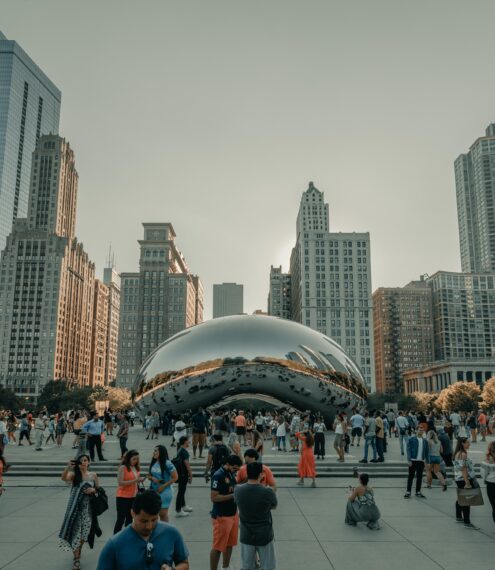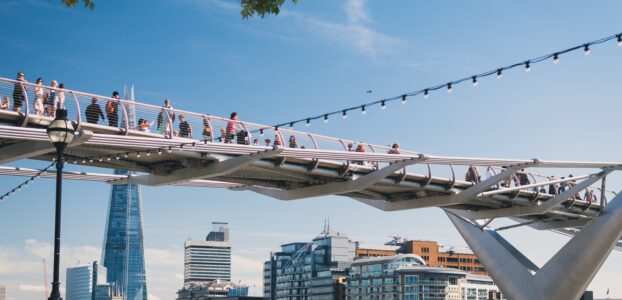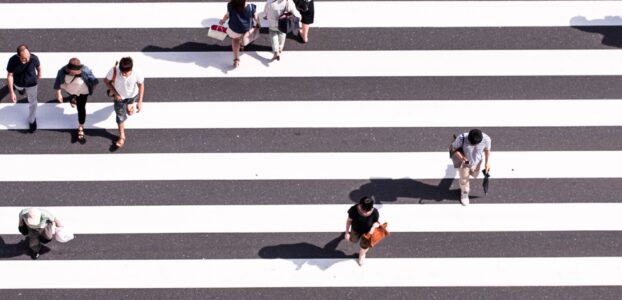Public spaces are spaces that are outdoors and open to all. Most public investment in these spaces aims to create or improve:
- Public realm, for example on high streets and in town centres
- Green spaces, including parks, parklets, and urban forests
- Active travel infrastructure, including cycle paths and footpaths
Whilst the primary benefits of public spaces are often social or environmental, there is increasing interest in their impact on the local economy. This briefing provides a framework to help policymakers think through the benefits and costs of investing in public spaces and replaces a previous briefing on public realm published in 2014
Summary of findings
Start by considering the scale of benefits.
- Where will benefit? For most schemes, benefits will be confined to the streets or neighbourhoods that receive investment.
- The impacts of most public space investments are likely to be small relative to the size of the local economy. Benchmarking can help provide a sense of scale.
For most schemes, investment will increase the attractiveness of a place. Investments in cycling and walking infrastructure can also improve accessibility. ‘Attractiveness’ or ‘accessibility’ are often referred to as ‘amenity values’ of a place. In many cases, the most obvious indicator to assess the effects of improved amenity values is an increase in footfall – for example, an increase in the number of people visiting a town centre or green space or making use of a cycle path. For most outcomes (other than property prices), this increase in footfall is also the precursor to other changes. Considerations include:
- Is the amenity value of a place – including its attractiveness or accessibility – a key issue limiting footfall? If not, it is unlikely that investment in public spaces will lead to substantive changes in local economic or health outcomes.
- Will improved public spaces change where residents and visitors spend disposable income and leisure time? Assessing this will require understanding current preferences and behaviours.
- Will the scheme lead to displacement within the local area? And are any elements of the scheme in conflict with each other? In both cases, this will reduce the overall impact of investment on the local area.
Estimated effects on footfall and spending can be used to estimate increases in turnover for affected businesses. These can then be used to estimate the direct jobs that could be created.
- Jobs may take time to emerge if businesses wait to see if increases in footfall and turnover are transitory or sustained.
- Additional jobs may also be created indirectly through purchases from local supply chains or those newly employed spending additional income locally. Multipliers can be used to estimate the effect on total jobs.
Are commercial or residential property prices likely to be affected? The benefits arising from public spaces schemes often increase property prices near to the scheme.
- Some schemes may cause property prices to fall if they make the area less attractive.
- Changing property prices may lead to changes in neighbourhood composition (i.e. in the type of households that live close to schemes).
In addition to local economic benefits, investment in public spaces could have a range of wider benefits, including on physical activity, health, use of public services, and pride in place. Carefully consider what wider benefits, if any, are likely to arise as a result of investment.
Rapid evidence reviews
The briefing draws on two rapid evidence reviews of the evaluation evidence.
Rapid evidence review: Public spaces
For this rapid evidence review, we looked for evaluation evidence of public spaces on local economic and wider outcomes. We searched for studies relating to public realm and green spaces, using a wide range of terms. We identified ten studies and three systematic reviews.
Key findings
- No studies look exclusively at public realm – but three studies look at interventions that involve a mix of activities including public realm improvements. None of the studies find overall effects but each finds some effects for specific cases or groups.
- There is a long tradition of using ‘hedonic’ analysis to understand how different attributes of properties – including proximity to green spaces – affect property prices. The evidence on the impact of green spaces on property prices is mixed, with effects varying across different types of green spaces.
- Generally, the evidence suggests that access to green spaces can improve health outcomes and perceptions of health, although in many cases effects are only observed for some measures of health or some definitions of green space, suggesting the relationship between green space and health is complex.
Need for more evidence
- We need more robust impact evaluations of public realm and green space schemes.
- There is a particular need for evaluation of local economic impacts such as employment and wages, and a need to understand the distributional impacts of investment in public spaces.
Rapid evidence review: Active travel infrastructure
For this rapid evidence review, we looked for evaluation evidence of active travel infrastructure on local economic and wider outcomes. We searched for studies relating to active travel infrastructure, using a wide range of terms including cycle paths, footpaths, pedestrianisation and traffic calming. We identified 22 studies. Most of the studies look at walking, either on its own or in combination with another mode of transport. Less than a third of studies look at cycling. This is surprising given that many countries, including the UK, have a strong policy focus on installing cycling infrastructure. The review also includes five systematic reviews.
Key findings
- For active travel infrastructure to have an impact on economic or other outcomes, such as health, it must first increase walking or cycling – for example, by changing perceptions of the feasibility or attractiveness of walking and cycling as an option. While individual studies suggest improving walkability may increase walking, they are some way from evidencing a strong causal link or providing a clear guide as to how active travel investments could change walkability, what aspects of walkability matter and for whom. The evidence on the causal links between investment in cycling infrastructure and cycling is stronger but limited.
- There is limited evidence on the impact of active travel infrastructure on local economic outcomes. The limited evidence, the variation in outcomes considered, and the mixed findings mean it is difficult to draw any general conclusions on whether investment in active travel infrastructure affects local economic performance.
- It is also not possible to draw general conclusions on whether investment in active travel infrastructure impacts property prices, although walkability does seem to be generally positively associated with increases in property prices.
- The evidence on the links between active travel infrastructure and health is limited and lower quality, and the findings are mixed.
Need for more evidence
- Given the increased interest in active travel, we encourage policymakers (including the Department for Transport, Active Travel England, devolved administrations, sub-national transport bodies, combined authorities and local authorities) to undertake robust impact evaluations of active travel policies and interventions.
- There is a particular need for more research into cycling and on the impact of active travel infrastructure on local economic outcomes.
- Evaluations should be conducted at the appropriate spatial scale – for example, considering displacement on to neighbouring areas – and should also consider effects on other transport modes.






